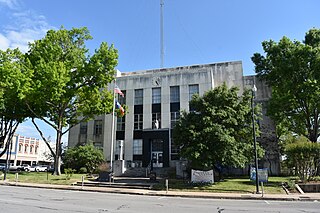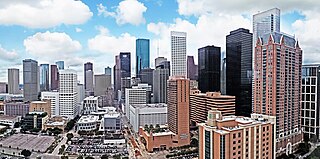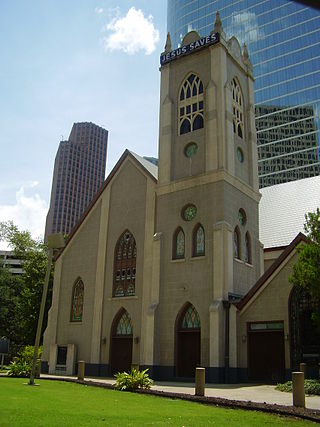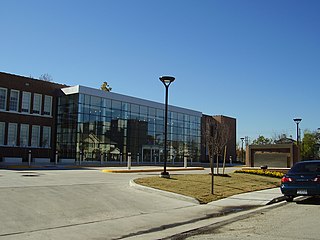Related Research Articles

Brenham is a city in east-central Texas in Washington County, United States, with a population of 17,369 according to the 2020 U.S. census. It is the county seat of Washington County.

The Fifth Ward is a community of Houston, Texas, United States, derived from a historical political district (ward), about 2 miles (3.2 km) northeast of Downtown. Its boundaries are Buffalo Bayou on the south, Jensen Drive on the west, Liberty Road on the north, and Lockwood Drive on the east.
APV may refer to:

The geographic areas of Houston are generally classified as either being inside or outside Interstate 610, colloquially called "the Loop". The Loop generally encircles the central business district and the "island cities" of West University Place, Southside Place, and a portion of Bellaire.

Heights High School, formerly John H. Reagan High School, is a senior high school located in the Houston Heights in Houston, Texas. It serves students in grades nine through twelve and is a part of the Houston Independent School District.

Sunnyside is a community in southern Houston, Texas, United States, south of Downtown Houston.

Third Ward is an area of Houston, Texas, United States, that evolved from one of the six historic wards of the same name. It is located in the southeast Houston management district.
Poinciana is a settlement and census-designated place (CDP) in Osceola and Polk counties in the U.S. state of Florida. It lies southwest of Kissimmee and approximately 14 miles (23 km) east of Haines City. As of the 2010 United States Census, the CDP had a population of 53,193.

Edgar Gregory-Abraham Lincoln Education Center (GLEC) is a K-8 school located at 1101 Taft in the Fourth Ward area of Houston, Texas, United States. Gregory-Lincoln is a part of the Houston Independent School District (HISD) and has a fine arts magnet program that takes students in both the elementary and middle school levels. Originally built in 1966 as Lincoln Junior and Senior High School, it later operated as Lincoln Junior High School until Gregory Elementary School merged into it in 1980, forming Gregory-Lincoln. The school moved into its current building in 2008; the rebuilding was delayed due to concerns that U.S. Civil War-era graveyards would be disturbed by the rebuilding process.

Fourth Ward is one of the historic six wards of Houston, Texas, United States. The Fourth Ward is located inside the 610 Loop directly west of and adjacent to Downtown Houston. The Fourth Ward is the site of Freedmen's Town, which was a post-U.S. Civil War community of African-Americans.

Antioch Missionary Baptist Church is a historic Baptist church at 313 Robin Street in Downtown Houston, Texas. It was historically a part of the Fourth Ward. As of 2012 it was the only remaining piece of the original Fourth Ward east of Interstate 45.

Historic Oaks of Allen Parkway Village, formerly Allen Parkway Village (APV) and San Felipe Courts Apartments, is a public housing complex in the northern Fourth Ward, Houston, Texas, operated by the Houston Housing Authority (HHA). Allen Parkway Village occupies 37 acres (15 ha) of land.

St. Joseph Medical Center (SJMC) is a general acute care hospital in Houston, Texas owned by Steward Health Care. Established in June 1887, SJMC is recognized as the first hospital in Houston. A new hospital was constructed in 1894, but was destroyed by fire soon thereafter. The hospital was rebuilt and it underwent major expansions in 1905 and 1938. The hospital was the largest in the city until the Texas Medical Center was established. The hospital has a capacity of 792 beds. A second location opened in the Houston Heights in 2012.

The African American population in Houston, Texas, has been a significant part of the city's community since its establishment. The Greater Houston area has the largest population of African Americans in Texas and west of the Mississippi River. Black Enterprise has referred to Houston as a black mecca.

Jefferson Davis Hospital operated from 1924 to 1989 and was the first centralized municipal hospital to treat indigent patients in Houston, Texas. It is listed in the National Register of Historic Places. The building, located in Houston's Historic First Ward, was designated as a protected historic landmark on November 13, 2013, by the Houston City Council and is monitored by the Historic Preservation Office of the City of Houston Department of Planning and Development. The property has been reoccupied by ArtSpace as the Elder Street Artists Lofts since 2005, which provides 24 live/work units for local artists to rent.

Rufus Cage Elementary School is an elementary school in Eastwood, a neighborhood in the East End district of Houston, Texas. It is a part of the Houston Independent School District (HISD). It serves a section of Eastwood. Founded as the Kirby School in 1902, it transitioned from a county school to a municipal school. The school, renamed after the death of the benefactor who donated land for the school, occupied a building dedicated in 1910 until its current campus opened in 1983, with the exception of the period 1914–1925, when the building was used as an apartment complex. The 1910 building is now a City of Houston historic landmark and is owned by the city government.
Houston Housing Authority (HHA), formerly Housing Authority of the City of Houston (HACH), is the public housing authority in Houston, Texas.

Susan V. Clayton Homes was a public housing unit in the Second Ward area of the East End district of Houston. Operated by the Houston Housing Authority (HHA), formerly the Housing Authority of the City of Houston (HACH), it was along Runnels Street, along the Buffalo Bayou and east of Downtown Houston. It was adjacent to railroad tracks and warehouses. It had 296 units.

African American Library at the Gregory School is a branch of the Houston Public Library (HPL) in the Fourth Ward, Houston. The library preserves historical information about the African-American community in Houston. It is the city's first library to focus on African-American history and culture. The library features galleries, an oral history recording room, and reading rooms. $11 million from federal community development block grants and construction funds from Houston Public Library and the City of Houston financed the renovation of the Gregory facility. The building was initially used as the Edgar M. Gregory School, a K-8 school of the Houston Independent School District (HISD).
References
- 1 2 3 4 5 6 7 Snyder, Mike; John D. Harden (2018-05-16). "Lenwood Johnson, public housing activist, dies at 75". Houston Chronicle . Retrieved 2019-01-02.
- 1 2 O'Brien, Timothy J. and David Ensminger. Mojo Hand: The Life and Music of Lightnin' Hopkins . University of Texas Press, April 1, 2013. ISBN 029274515X, 9780292745155. p. xi.
- 1 2 3 4 5 6 7 8 9 10 Wallstin, Brian (1995-12-24). "Lenwood Johnson's Last Stand". Houston Press . Retrieved 2019-01-04.
- ↑ "Lenwood Johnson". The Banner-Press . 2018-05-18. Retrieved 2019-01-04.
- ↑ O’Brien, Timothy. "Organizing lessons from Allen Parkway Village." San Francisco Bay View . September 17, 2009. Retrieved on July 3, 2011.
- ↑ Ghirardo, Diane Y. (1984). "Wielding the HACHet at Allen Parkway Village." In: Scardino, Barrie and Bruce C. Webb (editors). Ephemeral City: Cite Looks at Houston . University of Texas Press, December 1, 2003. Start: p. 100. ISBN 029270187X, 9780292701878. CITED: p. 102.
- 1 2 Lomax, John Nova (2012-07-03). "Lenwood Johnson: Trying to Save a Last Shred of Freedmen's Town History". Houston Press . Retrieved 2019-01-04.
- 1 2 3 4 5 6 Wallstin, Brian. "Allen Parkway Village: The Movie." Houston Press . Thursday May 6, 1999. Retrieved on January 2, 2019.
- ↑ Snyder, Mike (2001-12-14). "Tenant leader Johnson agrees to move out". Houston Chronicle . Retrieved 2019-01-02.
- ↑ Snyder, Mike (2002-01-15). "Eviction of four affirmed by city Housing Authority". Houston Chronicle . Retrieved 2019-01-02.
- ↑ "Lenwood Johnson, Houston community activist, dead at 75". KTRK-TV. 2018-05-16. Retrieved 2019-01-04.
- ↑ Adi, Hiba. "Critics accuse library of selective history." Houston Chronicle . November 13, 2010. Retrieved on December 4, 2010.